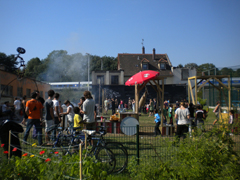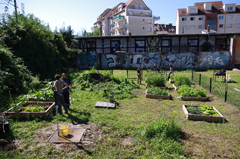Artists' Gardens / Jardins d'Artistes
Exhibit Category / Catégorie de l'expo: Community & Knowledge
Location/Emplacement: Lyon & Strasbourg, France
Jardin de l’association Zeûgme - Angle des Rues de Rothau & du Ban de la Roche - Strasbourg
La Réserve - angle des rues Delessert et Gouy - Lyon 7e
Dates: present
Designers/Concepteurs: Atelier des Friches; Association Zeûgme
Clients: n/a
More Information/Plus d'informations: http://assozeugme.blogspot.ca/; http://latelierdesfriches.fr/
Image Credits/Crédits d'images: Atelier des Friches; Association Zeûgme; Flore Giraud
Project Description: (version française ci-dessous)
In many French cities the activities of artists’ collectives are transforming abandoned sites into vibrant meeting places where socialization, education and, often, environmental activism take place. Frequently, these collectives are choosing to make community vegetable gardening into one of the primary activities at these sites.
In Paris, the Jardin d’Alice, located at 40, rue de la Chapelle, is an 800m2 space that was initially occupied illegally by an artists’ collective. The garden was eventually formally recognized and regulated. The space is host to a variety of activities including a vegetable garden.
In Lyon and Strasbourg, two similar gardens have precipitated the transformation of vacant lots into productive spaces filled with a spirit of creativity. Artist-activists have been the agents of this transformation and they hope to be agents in larger urban transformations.
The Zeûgme Association was initially formed to create interdisciplinary urban interventions. It was only later and by chance that the members proposed to convert a local and conspicuously derelict site into a centre for the exchange of ideas that would benefit the inhabitants of Strasbourg’s quartier de la Gare. A food garden seemed the best starting point for realizing this vision. The association was supported by local authorities and La Semencerie, a nearby artists’ centre, and it strove to include local residents in planning. This allowed for a rapid and officially recognized opening of the new garden space, which now operates on a collective basis. Thematic raised beds, in which participants can sow and harvest freely, surround a common space used for cultural performances, concerts, building experiments and other events. These activities have become the soul of the garden.
In Lyon, a particular interest by sculptor Céline Dodelin and Landscape Architect François Wattelier in derelict urban spaces led to the creation of the Atelier des Friches (Brownfield Studio), an “ecocitizen’s association”. Choosing an abandoned site at the heart of the Gerland housing estate as the epicentre of their activities in the neighbourhood, they named it La Réserve and divided it into three parts: one for nature, one for vegetables, and one for artistic pursuits. Originally squatters on this site, the Atelier des Friches eventually signed a property agreement with the City of Lyon in 2010. The knowledge that the use of the site was conditional helped inform the choice of crops used at the Jardin Gerland. A distinctive visual language, notably the use of bright red paint on planters and metal structures dispersed around the site, gives the project a clear identity.
Browse for more projects in the Carrot City Index.
Description du Projet:
Dans plusieurs villes de France, des collectifs d’artistes se regroupent pour pratiquer leurs activités dans des lieux abandonnés. Ces espaces sont ainsi transformés en lieu de rencontre à vocation sociale, éducative et souvent environnementale. La culture potagère est souvent devenu une partie intégrale d’un usage multifonctionnel d’espaces provisoires.
A Paris , le Jardin d’Alice, situé au 40, rue de la Chapelle, est un espace de 800 m2 qui a d’abord été occupé illégalement par un collectif d’artistes, avant que sa situation ne soit officiellement régularisée. L’endroit accueille de nombreuses manifestations mais également un potager.
A Lyon et Strasbourg, deux cas similaires ont vu la transformation de terrains vagues en espaces productifs et créatifs par des artistes-activistes voulant être acteurs du changement de leur ville.
L’association Zeûgme s’est constituée au départ pour créer des projets urbains interdisciplinaires. C’est plus tard, par hasard, que des membres ont proposé de convertir un terrain proche de chez eux et visiblement laissé à l’abandon, en lieu d’échange pouvant profiter à tous les habitants du quartier de la Gare de Strasbourg, et un jardin vivrier paraissait la solution la plus adaptée. Le soutien de la direction de proximité et des espaces verts et de la Semencerie, haut lieu artistique à proximité, ainsi que la communication envers les habitants avoisinants à pour les rendre véritablement participants, permis une ouverture rapide et officielle du nouveau jardin sur une base collective. Des bacs thématiques dans lesquels les gens sèment et récoltent librement entourent un espace culturel où des spectacles, événements, concerts, constructions, etc. font aujourd’hui l’âme du jardin.
A Lyon, un intérêt particulier dans les friches urbaines ont conduit une plasticienne (Céline Dodelin) et un paysagiste (François Wattelier) à créer l’Atelier des friches, une association à vocation écocitoyenne. Choisissant un terrain abandonné au cœur des Cités sociales de Gerland comme épicentre de leurs activités à travers tout le quartier, ils le nommèrent La Réserve et le divisèrent en trois parties : une pour la nature, une pour les légumes et la troisième pour les activités artistiques. D’abord squatter du terrain, l’Atelier des friches signa une convention immobilière avec la Ville de Lyon en 2010. Sachant que l’usage du terrain est provisoire informa les choix de cultures. Un vocabulaire artistique – notamment l’usage de la peinture rouge sur objets y compris des grands bacs collectifs et structures métalliques dispersées sur le site – permit de donner rapidement une identité au jardin.
Trouvez d’autres projets avec l’Index de Carrot City.
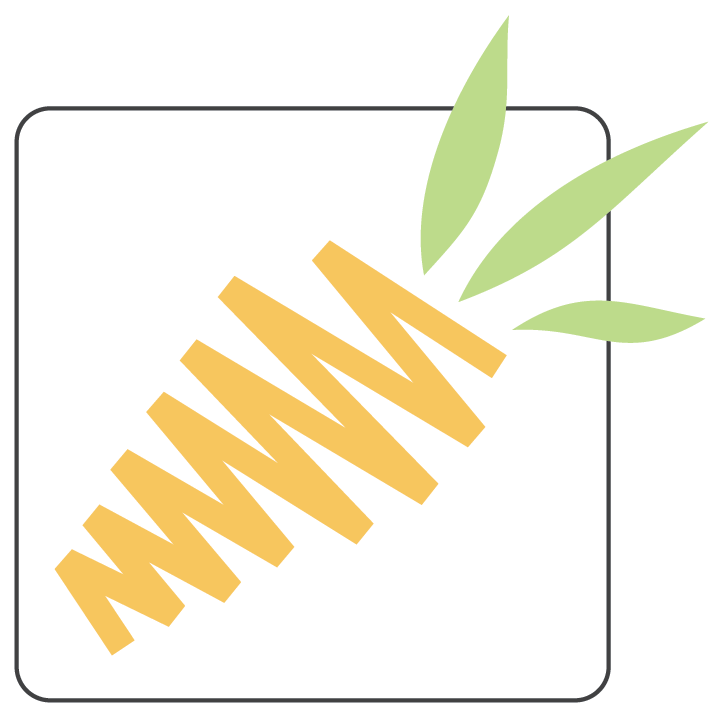

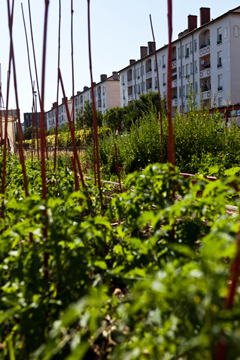
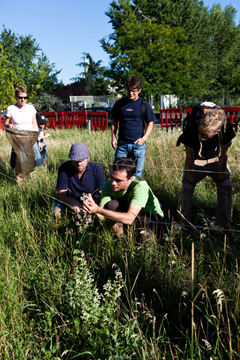
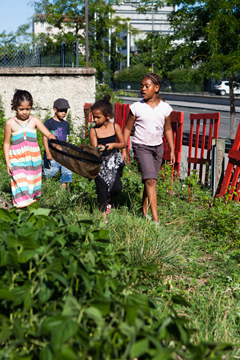
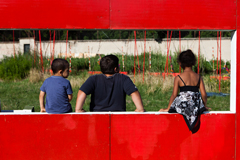
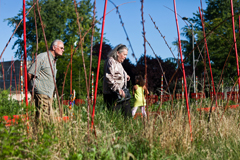
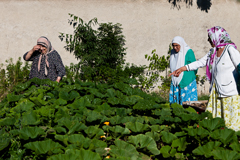
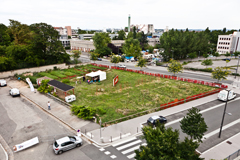
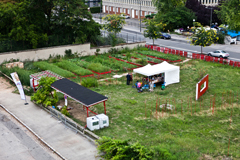
.jpg)
